Response of NDVI of Natural Vegetation to Climate Changes and Drought in China
Abstract
:1. Introduction
2. Study Area, Data, and Method
2.1. Study Area and Data
2.2. Method
3. Results
3.1. Changes to LUCC from 1980 to 2015
3.2. Spatial and Temporal Distribution of Growing Season Indices
3.3. Climate Change and Its Relationship with the NDVI
3.4. Effects of Drought on NDVI
4. Discussion
5. Conclusions
- (1)
- The area of urban and rural land in China increased by 49% from 1980 to 2015, with most of this increase attributed to conversion from agriculture land. Agriculture land and water increased by 33% and 20% in WNW, respectively, mainly through conversion from unutilized land and grassland. The increase in urban and rural land in ENW was mainly manifested as a massive reduction in unutilized land and grassland. Much of the decrease in glaciers and permanent snow on the Qinghai-Tibet Plateau could be attributed to conversion to unutilized land. The conversion of unutilized land, forests, and grasslands to farmland in NNC resulted in a significant increase in agriculture land. There were large reductions in agricultural land in SNC, WSC, and WSC due to conversion to urban and rural land.
- (2)
- SOS and EOS of natural vegetation in China showed trends of advancing and delay, respectively, during 1982–2015, resulting in GSL being prolonged by approximately eight days. SOS was advanced and EOS was delayed in WNW and ENW, leading to a 21 d and 10 d prolongation of GLS, respectively. Particularly in WNW, there were significant changes in the regional trends of the EOS and SOS. SOS was particularly important to GLS in ENW, with its contribution rate exceeding 80% in almost all vegetation types. Since NNC was dominated by forests and high-coverage grasslands, SOS and EOS were significantly advanced and delayed, respectively. The SOS had a greater impact on GLS than the EOS, with a contribution rate exceeding 71%. SOS was significantly advanced in SNC at both the regional and grid scales, whereas EOS and GLS also showed significant increasing trends. SOS showed a significant advancing trend in WSC and ESC, whereas EOS did not change significantly. TP showed a unique phenological change that was opposite to that in other regions. Although the phenological change in TP was not significant, SOS was delayed and EOS was advanced, resulting in a shortened GSL.
- (3)
- Temperature in China showed a significant increasing trend, whereas there was no significant change in precipitation. Although the NDVI showed a significant increasing trend, there were clear regional differences. The NDVI was positively correlated with precipitation in WNW and ENW, and the proportion of grids showing this correlation was higher for grassland than for forest. Rising air temperature was conducive to increasing the NDVI in WNW. Temperature was shown to be the key factor to controlling the growth of vegetation in TP rather than precipitation. In addition, the NDVI was affected by the temperature of the previous non-growing season. Precipitation is not the main factor affecting forested land in NNC. Rather, temperature had the greatest effect on vegetation, particularly in forests. Precipitation and temperature were both important for vegetation growth in SNC. However, temperature had a greater impact on vegetation in SNC. Temperature was the main environmental factor affecting vegetation dynamics in WSC and ESC, whereas the impact of precipitation was minimal.
- (4)
- In general, the SPEI showed a significant downward trend, particularly in WNW, ENW, and NNC. Drought had the greatest impact on the NDVI in WNW and ENW, with 21% and 56% of grids in this area showing a significantly positive correlation between the NDVI and the SPEI, with a higher proportion of grids showing this relationship for grassland than for forest. Approximately 10% of grids in TP, NNC, and SNC showed this significantly positive correlation, with this positive correlation much higher in grassland than in forest. The correlation between the NDVI and drought was weak in WSC and ESC, indicating that drought is not the main factor limiting vegetation growth.
Supplementary Materials
Author Contributions
Funding
Data Availability Statement
Acknowledgments
Conflicts of Interest
References
- Jia, L.; Li, Z.B.; Xu, G.C.; Ren, Z.P.; Li, P.; Cheng, Y.T.; Zhang, Y.X.; Wang, B.; Zhang, J.-X.; Yu, S. Dynamic change of vegetation and its response to climate and topographic factors in the Xijiang River basin, China. Environ. Sci. Pollut. R 2020, 27, 11637–11648. [Google Scholar] [CrossRef]
- Thomas, C.D.; Cameron, A.; Green, R.E.; Bakkenes, M.; Beaumont, L.J.; Collingham, Y.C.; Erasmus, B.F.; Siqueira, M.D.; Grainger, A.; Hannah, L. Extinction risk from climate change. Nature 2004, 427, 145. [Google Scholar] [CrossRef]
- Maclean, I.M.; Wilson, R.J. Recent ecological responses to climate change support predictions of high extinction risk. Proc. Natl. A Sci. 2011, 108, 12337–12342. [Google Scholar] [CrossRef] [Green Version]
- Zheng, H.; Shen, G.; He, X.; Yu, X.; Ren, Z.; Zhang, D. Spatial assessment of vegetation vulnerability to accumulated drought in Northeast China. Reg. Environ. Chang. 2015, 15, 1639–1650. [Google Scholar] [CrossRef]
- Kasoro, F.R.; Yan, L.; Zhang, W.; Asante-Badu, B. Spatial and temporal changes of vegetation cover in china based on modis ndvi. Appl. Ecol. Environ. Res. 2021, 19, 1371–1390. [Google Scholar] [CrossRef]
- Luo, N.; Mao, D.; Wen, B.; Liu, X. Climate Change Affected Vegetation Dynamics in the Northern Xinjiang of China: Evaluation by SPEI and NDVI. Land 2020, 9, 90. [Google Scholar] [CrossRef] [Green Version]
- Song, X.-P.; Hansen, M.C.; Stehman, S.V.; Potapov, P.V.; Tyukavina, A.; Vermote, E.F.; Townshend, J.R. Global land change from 1982 to 2016. Nature 2018, 560, 639–643. [Google Scholar] [CrossRef] [PubMed]
- Chen, C.; Park, T.; Wang, X.; Piao, S.; Xu, B.; Chaturvedi, R.K.; Fuchs, R.; Brovkin, V.; Ciais, P.; Fensholt, R. China and India lead in greening of the world through land-use management. Nat. Sustain. 2019, 2, 122–129. [Google Scholar] [CrossRef]
- Wu, D.; Wu, H.; Zhao, X.; Zhou, T.; Tang, B.; Zhao, W.; Jia, K. Evaluation of spatiotemporal variations of global fractional vegetation cover based on GIMMS NDVI data from 1982 to 2011. Remote Sens. 2014, 6, 4217–4239. [Google Scholar] [CrossRef] [Green Version]
- Piao, S.; Wang, X.; Ciais, P.; Zhu, B.; Wang, T.; Liu, J. Changes in satellite-derived vegetation growth trend in temperate and boreal Eurasia from 1982 to 2006. Global. Chang. Biol. 2011, 17, 3228–3239. [Google Scholar] [CrossRef]
- Zheng, K.; Tan, L.; Sun, Y.; Wu, Y.; Duan, Z.; Xu, Y.; Gao, C. Impacts of climate change and anthropogenic activities on vegetation change: Evidence from typical areas in China. Ecol. Indic. 2021, 126, 107648. [Google Scholar] [CrossRef]
- Zhou, L.; Tucker, C.J.; Kaufmann, R.K.; Slayback, D.; Shabanov, N.V.; Myneni, R.B. Variations in northern vegetation activity inferred from satellite data of vegetation index during 1981 to 1999. J. Geophys. Res.-Atmos. 2001, 106, 20069–20083. [Google Scholar] [CrossRef]
- Lamchin, M.; Lee, W.-K.; Jeon, S.W.; Wang, S.W.; Lim, C.H.; Song, C.; Sung, M. Long-term trend and correlation between vegetation greenness and climate variables in Asia based on satellite data. Sci. Total Environ. 2018, 618, 1089–1095. [Google Scholar] [CrossRef] [PubMed]
- Sun, W.; Song, X.; Mu, X.; Gao, P.; Wang, F.; Zhao, G. Spatiotemporal vegetation cover variations associated with climate change and ecological restoration in the Loess Plateau. Agric. Forest Meteorol. 2015, 209, 87–99. [Google Scholar] [CrossRef]
- Guo, J.; Hu, Y.; Xiong, Z.; Yan, X.; Ren, B.; Bu, R. Spatiotemporal Variations of Growing-Season NDVI Associated with Climate Change in Northeastern China’s Permafrost Zone. Pol. J. Environ. Stud. 2017, 26, 1521–1530. [Google Scholar] [CrossRef]
- Lin, X.; Niu, J.; Berndtsson, R.; Yu, X.; Zhang, L.; Chen, X. NDVI dynamics and its response to climate change and reforestation in Northern China. Remote Sens. 2020, 12, 4138. [Google Scholar] [CrossRef]
- Li, P.; Wang, J.; Liu, M.; Xue, Z.; Bagherzadeh, A.; Liu, M. Spatio-temporal variation characteristics of NDVI and its response to climate on the Loess Plateau from 1985 to 2015. Catena 2021, 203, 105331. [Google Scholar] [CrossRef]
- Pang, G.; Wang, X.; Yang, M. Using the NDVI to identify variations in, and responses of, vegetation to climate change on the Tibetan Plateau from 1982 to 2012. Quat. Int. 2017, 444, 87–96. [Google Scholar] [CrossRef]
- Wang, H.; Pan, Y.; Chen, Y. Comparison of three drought indices and their evolutionary characteristics in the arid region of northwestern China. Atmos. Sci. Lett. 2017, 18, 132–139. [Google Scholar] [CrossRef]
- Beguería, S.; Vicente-Serrano, S.M.; Reig, F.; Latorre, B. Standardized precipitation evapotranspiration index (SPEI) revisited: Parameter fitting, evapotranspiration models, tools, datasets and drought monitoring. Int. J. Climatol. 2014, 34, 3001–3023. [Google Scholar] [CrossRef] [Green Version]
- Li, X.; Li, Y.; Chen, A.; Gao, M.; Slette, I.J.; Piao, S. The impact of the 2009/2010 drought on vegetation growth and terrestrial carbon balance in Southwest China. Agric. Forest Meteorol. 2019, 269, 239–248. [Google Scholar] [CrossRef]
- Fang, W.; Huang, S.; Huang, Q.; Huang, G.; Wang, H.; Leng, G.; Wang, L.; Li, P.; Ma, L. Bivariate probabilistic quantification of drought impacts on terrestrial vegetation dynamics in mainland China. J. Hydrol. 2019, 577, 123980. [Google Scholar] [CrossRef]
- Xu, H.J.; Wang, X.P.; Zhao, C.Y.; Zhang, X.X. Responses of ecosystem water use efficiency to meteorological drought under different biomes and drought magnitudes in northern China. Agric. Forest Meteorol. 2019, 278, 107660. [Google Scholar] [CrossRef]
- Vicente-Serrano, S.M.; Gouveia, C.; Camarero, J.J.; Beguería, S.; Trigo, R.; López-Moreno, J.I.; Azorín-Molina, C.; Pasho, E.; Lorenzo-Lacruz, J.; Revuelto, J. Response of vegetation to drought time-scales across global land biomes. Proc. Natl. Acad. Sci. USA 2013, 110, 52–57. [Google Scholar] [CrossRef] [PubMed] [Green Version]
- Wang, H.; Chen, Y.; Pan, Y.; Chen, Z.; Ren, Z. Assessment of candidate distributions for SPI/SPEI and sensitivity of drought to climatic variables in China. Int. J. Climatol. 2019, 39, 4392–4412. [Google Scholar] [CrossRef]
- Wang, H.; Liu, X.; Zhang, X.; Wang, P.; Lin, H.; Yu, L. Spatiotemporal crop NDVI responses to climatic factors in mainland China. Int. J. Remote Sens. 2019, 40, 89–103. [Google Scholar] [CrossRef]
- Zhou, Y.; Fu, D.; Lu, C.; Xu, X.; Tang, Q. Positive effects of ecological restoration policies on the vegetation dynamics in a typical ecologically vulnerable area of China. Ecol. Eng. 2021, 159, 106087. [Google Scholar] [CrossRef]
- Yu, M.; Gao, Q. Increasing Summer Rainfall and Asymmetrical Diurnal and Seasonal Warming Enhanced Vegetation Greenness in Temperate Deciduous Forests and Grasslands of Northern China. Remote Sens. 2020, 12, 2569. [Google Scholar] [CrossRef]
- Peng, S.Z.; Ding, Y.X.; Liu, W.Z.; Li, Z. 1 km monthly temperature and precipitation dataset for China from 1901 to 2017. Earth Syst. Sci. Data 2019, 11, 1931–1946. [Google Scholar] [CrossRef] [Green Version]
- Eklundh, L.; Jönsson, P. TIMESAT for processing time-series data from satellite sensors for land surface monitoring. In Multitemporal Remote Sensing; Ban, Y., Ed.; Springer International Publishing: Berlin/Heidelberg, Germany, 2016; pp. 177–194. [Google Scholar]
- Nally, R.M. Hierarchical partitioning as an interpretative tool in multivariate inference. Aust. J. Ecol. 1996, 21, 224–228. [Google Scholar] [CrossRef]
- Sen, P.K. Estimates of the regression coefficient based on Kendall’s Tau. J. Am. Stat. Assoc. 1968, 63, 1379–1389. [Google Scholar] [CrossRef]
- Kendall, M.G. Rank-Correlation Measures; Charles Griffin: London, UK, 1975. [Google Scholar]
- Yue, S.; Pilon, P.; Cavadias, G. Power of the Mann–Kendall and Spearman’s rho tests for detecting monotonic trends in hydrological series. J. Hydrol. 2002, 259, 254–271. [Google Scholar] [CrossRef]
- Bronaugh, D.; Werner, A. Zyp: Zhang + Yue-Pilon Trends Package. R Package Version 0.10-1. 2013. Available online: https://CRAN.Rproject.org/package=zyp (accessed on 5 October 2018).
- Zhao, A.; Zhang, A.; Liu, J.; Feng, L.; Zhao, Y. Assessing the effects of drought and “Grain for Green” Program on vegetation dynamics in China′s Loess Plateau from 2000 to 2014. Catena 2019, 175, 446–455. [Google Scholar] [CrossRef]
- Zhang, X.; Du, X.; Hong, J.; Du, Z.; Lu, X.; Wang, X. Effects of climate change on the growing season of alpine grassland in Northern Tibet, China. Glob. Ecol. Conserv. 2020, 23, e01126. [Google Scholar] [CrossRef]
- Zhang, Q.; Kong, D.; Singh, V.P.; Shi, P. Response of vegetation to different time-scales drought across China: Spatiotemporal patterns, causes and implications. Glob. Planet. Chang. 2017, 152, 1–11. [Google Scholar] [CrossRef] [Green Version]
- Xu, W.; Liu, H.; Zhang, Q.; Liu, P. Response of vegetation ecosystem to climate change based on remote sensing and information entropy: A case study in the arid inland river basin of China. Environ. Earth Sci. 2021, 80, 1–14. [Google Scholar] [CrossRef]
- Yu, Y.; Shen, Y.; Wang, J.; Wei, Y.; Nong, L.; Deng, H. Assessing the response of vegetation change to drought during 2009-2018 in Yunnan Province, China. Environ. Sci. Pollut. R 2021, 1–17. [Google Scholar] [CrossRef]
- Xu, H.J.; Wang, X.P.; Zhao, C.Y.; Yang, X.M. Assessing the response of vegetation photosynthesis to meteorological drought across northern China. Land Degrad. Dev. 2021, 32, 20–34. [Google Scholar] [CrossRef]
- Davidson, E.A.; Verchot, L.V.; Cattânio, J.H.; Ackerman, I.L.; Carvalho, J. Effects of soil water content on soil respiration in forests and cattle pastures of eastern Amazonia. Biogeochemistry 2000, 48, 53–69. [Google Scholar] [CrossRef]
- Thavorntam, W.; Tantemsapya, N. Vegetation greenness modeling in response to climate change for Northeast Thailand. J. Geogr. Sci. 2013, 23, 1052–1068. [Google Scholar] [CrossRef]
- Zhou, K.; Li, J.; Zhang, T.; Kang, A. The use of combined soil moisture data to characterize agricultural drought conditions and the relationship among different drought types in China. Agric. Water Manag. 2021, 243, 106479. [Google Scholar] [CrossRef]
- Zhao, W.; Hu, Z.; Guo, Q.; Wu, G.; Chen, R.; Li, S. Contributions of Climatic Factors to Interannual Variability of the Vegetation Index in Northern China Grasslands. J. Clim. 2020, 33, 175–183. [Google Scholar] [CrossRef]
- Xia, J.; Yan, Z.; Jia, G.; Zeng, H.; Jones, P.D.; Zhou, W.; Zhang, A. Projections of the advance in the start of the growing season during the 21st century based on CMIP5 simulations. Adv. Atmos. Sci. 2015, 32, 831–838. [Google Scholar] [CrossRef]
- Garonna, I.; De Jong, R.; De Wit, A.J.; Mücher, C.A.; Schmid, B.; Schaepman, M.E. Strong contribution of autumn phenology to changes in satellite-derived growing season length estimates across Europe (1982–2011). Glob. Chang. Biol. 2014, 20, 3457–3470. [Google Scholar] [CrossRef]
- Piao, S.; Fang, J.; Zhou, L.; Ciais, P.; Zhu, B. Variations in satellite-derived phenology in China’s temperate vegetation. Glob. Chang. Biol. 2006, 12, 672–685. [Google Scholar] [CrossRef]
- He, Z.; Du, J.; Chen, L.; Zhu, X.; Lin, P.; Zhao, M.; Fang, S. Impacts of recent climate extremes on spring phenology in arid-mountain ecosystems in China. Agric. Forest Meteorol. 2018, 260, 31–40. [Google Scholar] [CrossRef]
- Toledo, M.; Poorter, L.; Pea-Claros, M.; Alarcón, A.; Bongers, F. Climate is a stronger driver of tree and forest growth rates than soil and disturbance. J. Ecol. 2011, 99, 254–264. [Google Scholar] [CrossRef]
- Temperature, precipitation, and insolation effects on autumn vegetation phenology in temperate China. Glob. Chang. Biol. 2016, 22, 644–655. [CrossRef]
- Wang, X.; Wu, C.; Peng, D.; Gonsamo, A.; Liu, Z. Snow cover phenology affects alpine vegetation growth dynamics on the Tibetan Plateau: Satellite observed evidence, impacts of different biomes, and climate drivers. Agric. Forest Meteorol. 2018, 256, 61–74. [Google Scholar] [CrossRef]
- Chen, H.; Zhu, Q.; Wu, N.; Wang, Y.; Peng, C. Delayed spring phenology on the Tibetan Plateau may also be attributable to other factors than winter and spring warming. Proc. Natl. Acad. Sci. USA 2011, 108, E93. [Google Scholar] [CrossRef] [PubMed] [Green Version]
- Yi, S.; Zhou, Z. Increasing contamination might have delayed spring phenology on the Tibetan Plateau. Proc. Natl. Acad. Sci. USA 2011, 108, E94. [Google Scholar] [CrossRef] [Green Version]
- Zhang, G.; Zhang, Y.; Dong, J.; Xiao, X. Green-up dates in the Tibetan Plateau have continuously advanced from 1982 to 2011. Proc. Natl. Acad. Sci. USA 2013, 110, 4309–4314. [Google Scholar] [CrossRef] [PubMed] [Green Version]
- Zhang, X.; Friedl, M.A.; Schaaf, C.B.; Strahler, A.H. Climate controls on vegetation phenological patterns in northern mid-and high latitudes inferred from MODIS data. Glob. Chang. Biol. 2004, 10, 1133–1145. [Google Scholar] [CrossRef]
- Spano, D.; Cesaraccio, C.; Duce, P.; Snyder, R.L. Phenological stages of natural species and their use as climate indicators. Int. J. Biometeorol. 1999, 42, 124–133. [Google Scholar] [CrossRef]
- Potop, V.; Možný, M.; Soukup, J. Drought evolution at various time scales in the lowland regions and their impact on vegetable crops in the Czech Republic. Agric. For. Meteorol. 2012, 156, 121–133. [Google Scholar] [CrossRef]
- Liu, Z.P.; Wang, Y.Q.; Shao, M.G.; Jia, X.X.; Li, X.L. Spatiotemporal analysis of multiscalar drought characteristics across the Loess Plateau of China. J. Hydrol. 2016, 534, 281–299. [Google Scholar] [CrossRef]
- Knapp, A.K.; Carroll, C.J.; Denton, E.M.; La Pierre, K.J.; Collins, S.L.; Smith, M.D. Differential sensitivity to regional-scale drought in six central US grasslands. Oecologia 2015, 177, 949–957. [Google Scholar] [CrossRef] [PubMed] [Green Version]
- Phillips, O.L.; Aragão, L.E.O.C.; Lewis, S.L. Drought sensitivity of the Amazon rainfores. Science 2009, 323, 1344–1347. [Google Scholar] [CrossRef] [Green Version]
- Yan, M.; Xue, M.; Zhang, L.; Tian, X.; Chen, B.; Dong, Y. A Decade′s Change in Vegetation Productivity and Its Response to Climate Change over Northeast China. Plants-Basel 2021, 10, 821. [Google Scholar] [CrossRef]
- Wang, M.; Gong, Y.; Lafleur, P.; Wu, Y. Patterns and drivers of carbon, nitrogen and phosphorus stoichiometry in Southern China’s grasslands. Sci. Total Environ. 2021, 785, 147201. [Google Scholar] [CrossRef]
- Wang, H.; Yan, S.; Liang, Z.; Jiao, K.; Li, D.; Wei, F.; Li, S. Strength of association between vegetation greenness and its drivers across China between 1982 and 2015: Regional differences and temporal variations. Ecol. Indic. 2021, 128, 107831. [Google Scholar] [CrossRef]
- Jiang, S.; Chen, X.; Smettem, K.; Wang, T. Climate and land use influences on changing spatiotemporal patterns of mountain vegetation cover in southwest China. Ecol. Indic. 2021, 121, 107193. [Google Scholar] [CrossRef]
- Peng, J.; Jiang, H.; Liu, Q.; Green, S.M.; Quine, T.A.; Liu, H.; Qiu, S.; Liu, Y.; Meersmans, J. Human activity vs. climate change: Distinguishing dominant drivers on LAI dynamics in karst region of southwest China. Sci. Total Environ. 2021, 769, 144297. [Google Scholar] [CrossRef] [PubMed]
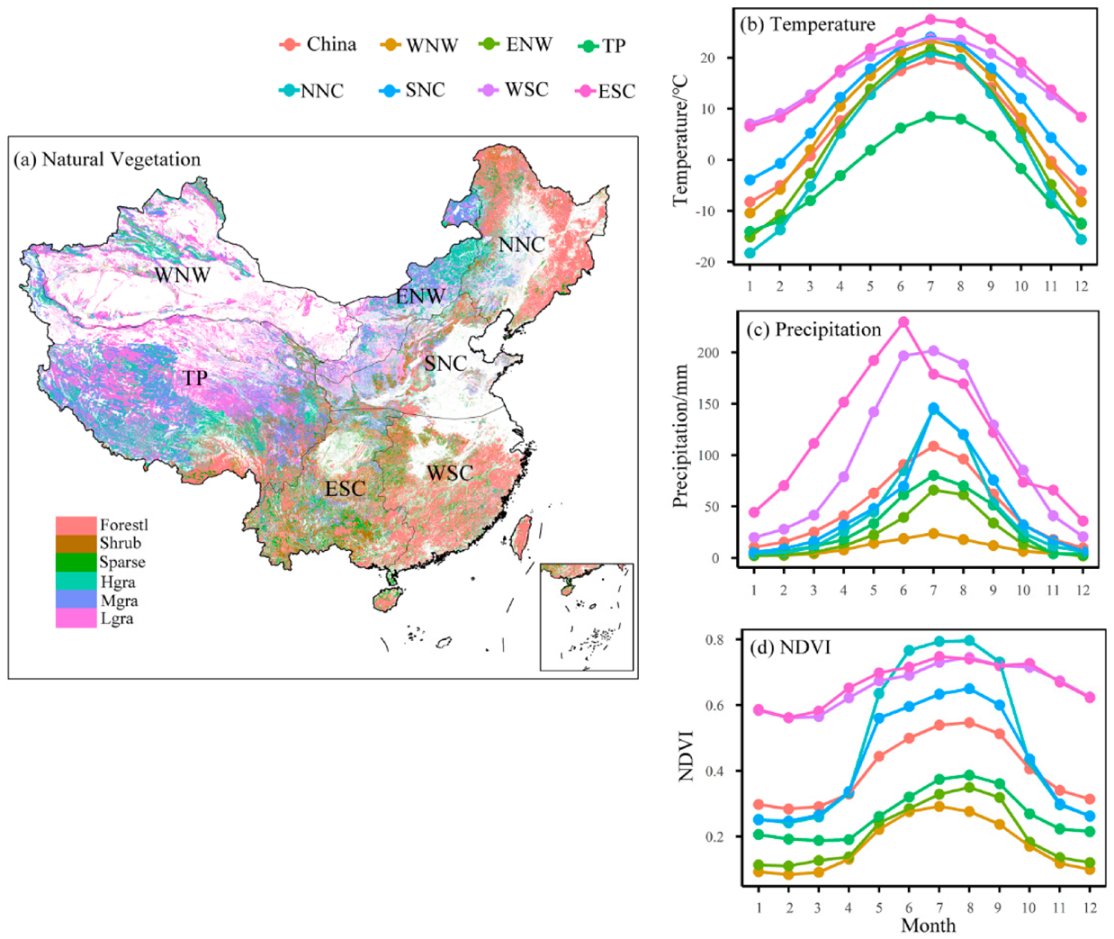
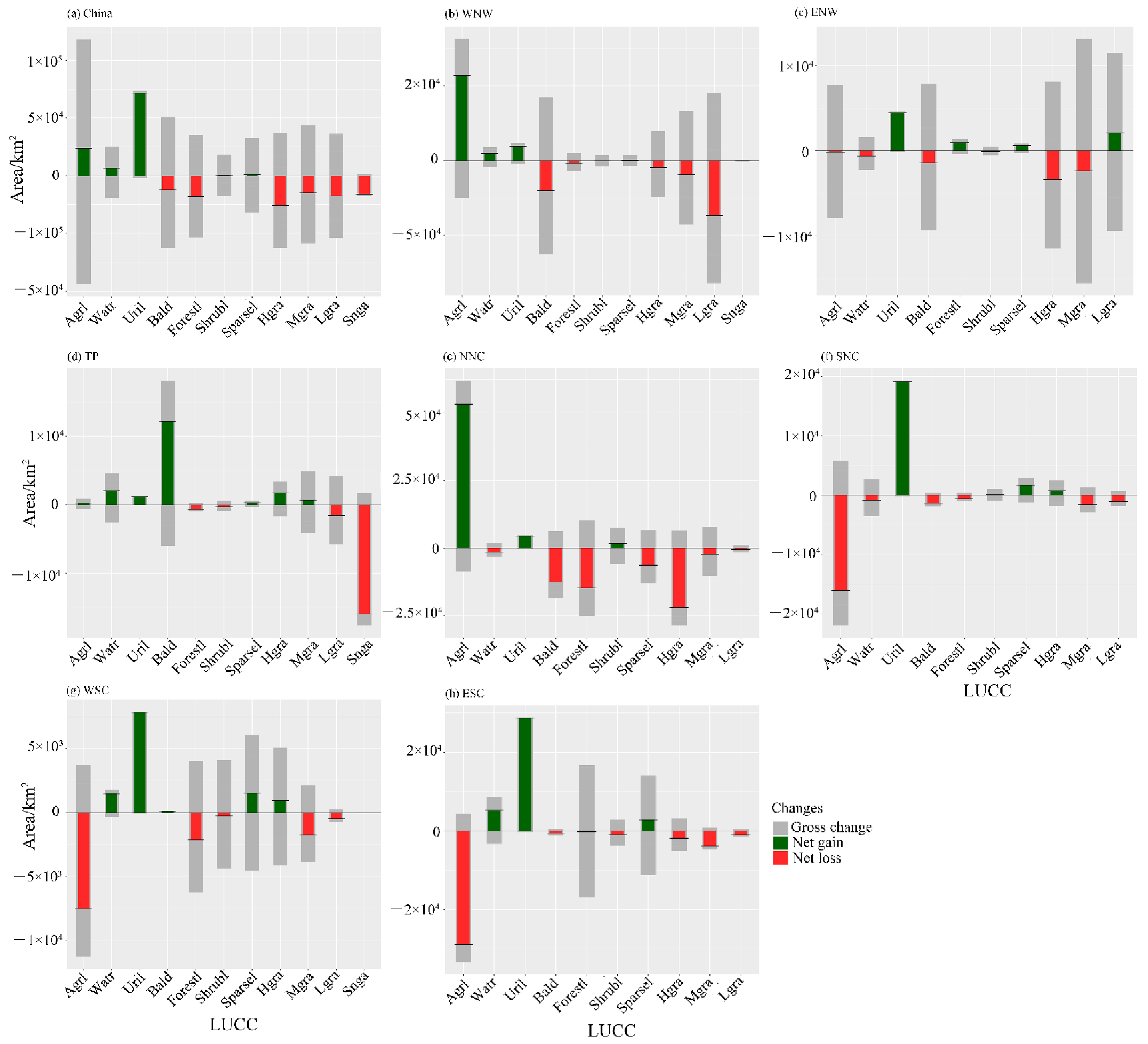
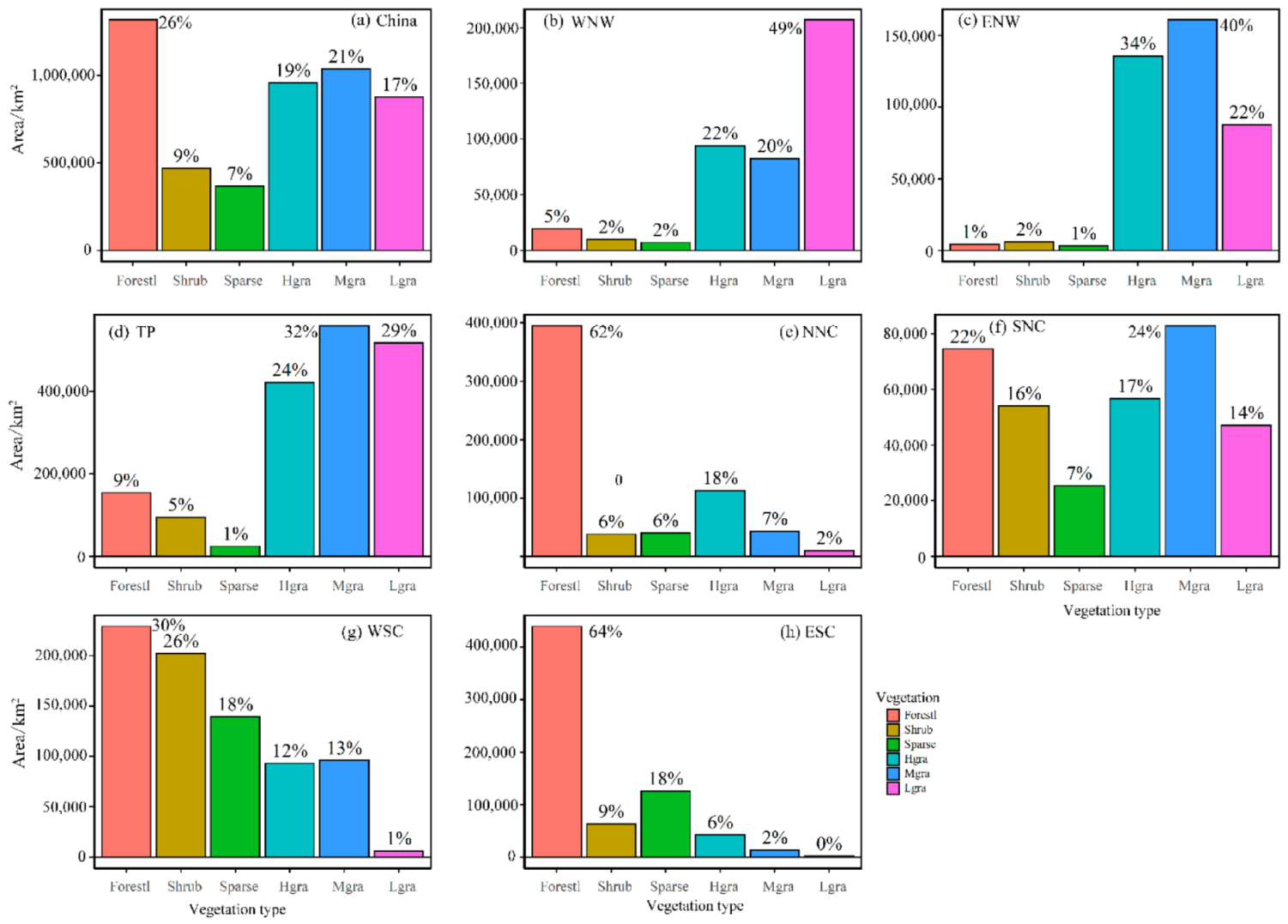
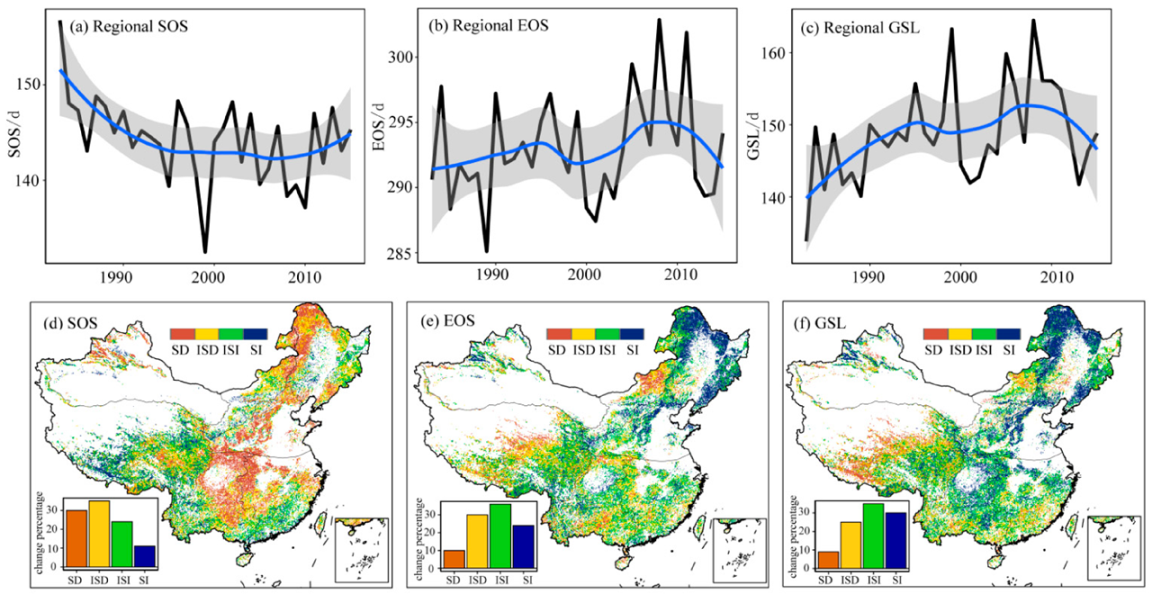
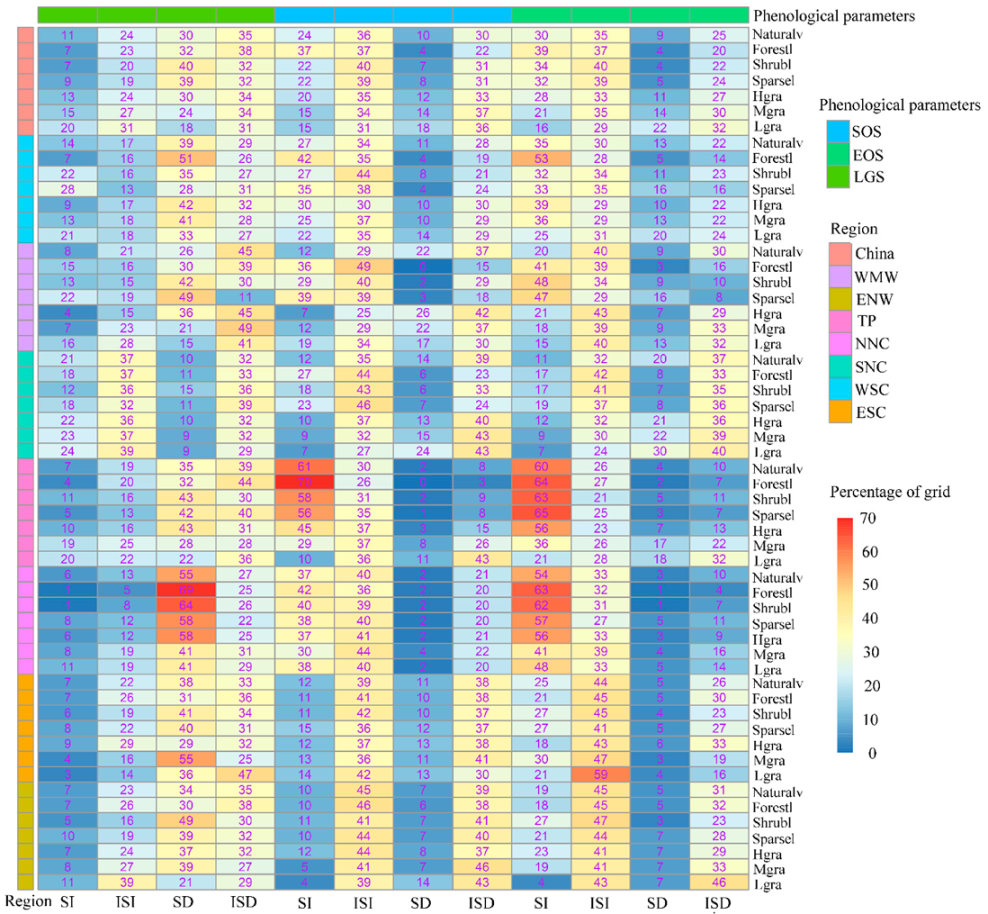

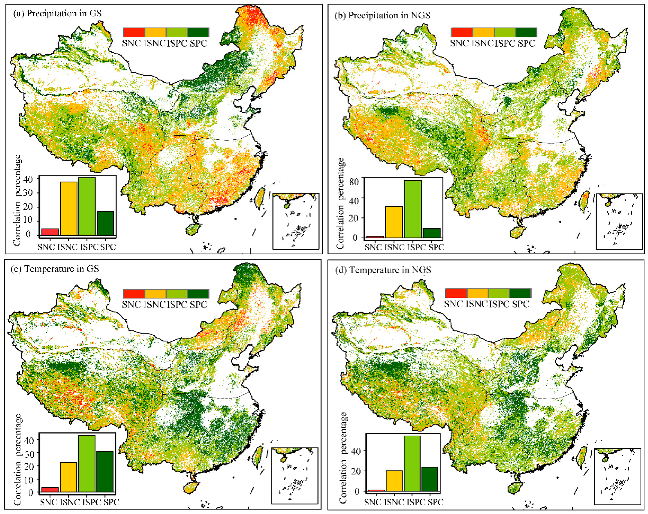
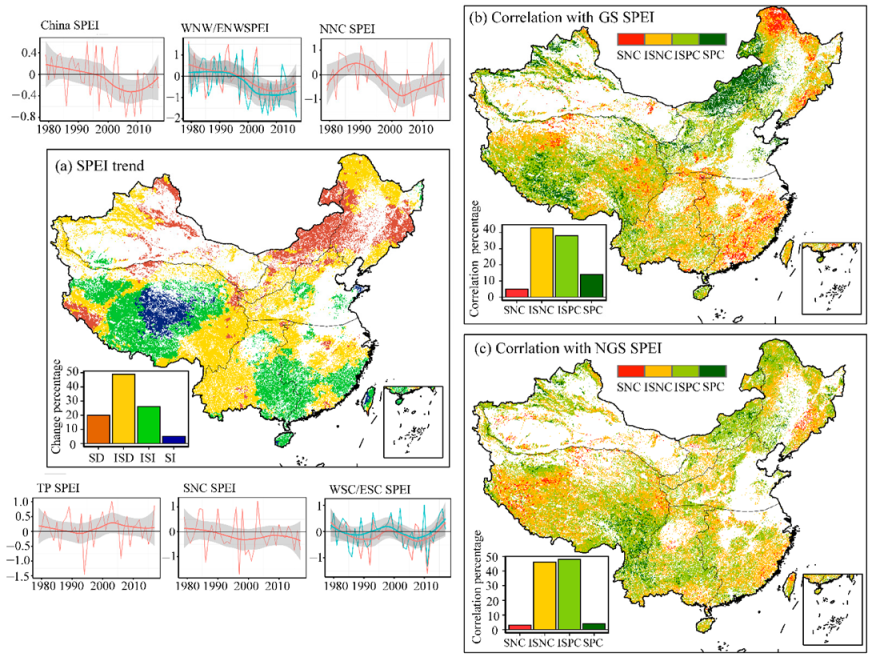
| Agrl | Watr | Uril | Bald | Forestl | Shrubl | Sparsel | Hgra | Mgra | Lgra | Snga | ||
|---|---|---|---|---|---|---|---|---|---|---|---|---|
| China | 1980 | 1,762,034 | 202,729 | 148,945 | 1,996,499 | 1,372,015 | 486,377 | 398,411 | 1,020,430 | 1,096,193 | 931,243 | 84,952 |
| 2015 | 1,786,003 | 211,092 | 221,863 | 1,984,536 | 1,353,990 | 486,920 | 399,242 | 995,106 | 1,081,483 | 913,987 | 69,009 | |
| % | 1.36 | 4.13 | 48.96 | −0.60 | −1.31 | 0.11 | 0.21 | −2.48 | −1.34 | −1.85 | −18.77 | |
| WNW | 1980 | 69,257 | 9819 | 4396 | 1,167,635 | 22,248 | 11,125 | 8445 | 103,707 | 99,511 | 239,765 | 17,319 |
| 2015 | 92,118 | 11,761 | 8317 | 1,159,588 | 21,521 | 11,119 | 8608 | 101,949 | 95,808 | 225,118 | 17,316 | |
| % | 33.01 | 19.78 | 89.20 | −0.69 | −3.27 | −0.05 | 1.93 | −1.70 | −3.72 | −6.11 | −0.02 | |
| ENW | 1980 | 78,574 | 12,321 | 7202 | 90,230 | 4728 | 6558 | 3527 | 147,240 | 176,404 | 97,131 | 0 |
| 2015 | 78,412 | 11,693 | 11,657 | 88,793 | 5661 | 6485 | 4118 | 143,826 | 174,026 | 99,243 | 0 | |
| % | −0.21 | −5.10 | 61.86 | −1.59 | 19.73 | −1.11 | 16.76 | −2.32 | −1.35 | 2.17 | 0.00 | |
| TP | 1980 | 18,628 | 58,517 | 1132 | 653,283 | 154,991 | 95,677 | 24,977 | 422,809 | 562,793 | 522,590 | 67,206 |
| 2015 | 18,852 | 60,565 | 2312 | 665,480 | 154,325 | 95,403 | 25,278 | 424,553 | 563,509 | 521,025 | 51,299 | |
| % | 1.20 | 3.50 | 104.24 | 1.87 | −0.43 | −0.29 | 1.21 | 0.41 | 0.13 | −0.30 | −23.67 | |
| NNC | 1980 | 320,340 | 27,992 | 26,100 | 74,683 | 420,310 | 44,057 | 52,876 | 141,428 | 53,231 | 11,944 | 0 |
| 2015 | 373,669 | 26,676 | 30,545 | 62,293 | 405,574 | 45,927 | 46,562 | 119,515 | 50,927 | 11,311 | 2 | |
| % | 16.65 | −4.70 | 17.03 | −16.59 | −3.51 | 4.25 | −11.94 | −15.49 | −4.33 | −5.30 | 0 | |
| SNC | 1980 | 490,439 | 22,417 | 62,113 | 5289 | 75,574 | 54,972 | 26,604 | 58,500 | 85,793 | 48,876 | 9 |
| 2015 | 474,408 | 21,555 | 81,278 | 3871 | 74,977 | 55,060 | 28,250 | 59,222 | 84,222 | 47,755 | 9 | |
| % | −3.27 | −3.85 | 30.86 | −26.81 | −0.79 | 0.16 | 6.19 | 1.23 | −1.83 | −2.29 | 0 | |
| WSC | 1980 | 345,232 | 9956 | 8874 | 679 | 235,450 | 206,443 | 143,865 | 97,473 | 99,798 | 6830 | 9 |
| 2015 | 337,742 | 11,509 | 16,723 | 821 | 233,329 | 206,197 | 145,435 | 98,442 | 98,068 | 6375 | 12 | |
| % | −2.17 | 15.60 | 88.45 | 20.91 | −0.90 | −0.12 | 1.09 | 0.99 | −1.73 | −6.66 | 33.33 | |
| ESC | 1980 | 436,067 | 51,663 | 37,979 | 2846 | 456,253 | 66,864 | 137,180 | 47,601 | 18,111 | 3695 | 0 |
| 2015 | 407,203 | 56,981 | 66,766 | 2257 | 456,116 | 66,051 | 140,091 | 45,806 | 14,351 | 2733 | 0 | |
| % | −6.62 | 10.29 | 75.80 | −20.70 | −0.03 | −1.22 | 2.12 | −3.77 | −20.76 | −26.04 | 0 |
| Growing Season (Day of Year) | Trend (Days/34 Years) | Contribution Rate for GSL (%) | |||||||
|---|---|---|---|---|---|---|---|---|---|
| SOS | EOS | GSL | SOS | EOS | GSL | SOS | EOS | ||
| China | Naturalv | 114 | 263 | 149 | −5 | 2 | 8 | 53 | 46.8 |
| Forestl | 108 | 267 | 159 | −6 | 5 | 12 | 45 | 55.1 | |
| Shrubl | 112 | 274 | 162 | −10 | 0 | 7 | 48 | 51.7 | |
| Sparsel | 107 | 281 | 173 | −14 | −1 | 13 | 40 | 60.2 | |
| Hgra | 119 | 257 | 139 | −5 | 3 | 6 | 55 | 44.9 | |
| Mgra | 122 | 258 | 136 | −4 | 2 | 7 | 60 | 40.5 | |
| Lgra | 126 | 256 | 130 | −1 | 1 | 2 | 55 | 45.2 | |
| WNW | Naturalv | 108 | 255 | 147 | −12 | 9 | 21 | 51 | 48.9 |
| Forestl | 109 | 254 | 145 | −12 | 11 | 23 | 51 | 49.1 | |
| Shrubl | 105 | 258 | 152 | −12 | 10 | 23 | 51 | 49.1 | |
| Sparsel | 109 | 254 | 145 | −5 | 11 | 15 | 46 | 54.1 | |
| Hgra | 112 | 253 | 141 | −12 | 9 | 21 | 56 | 44.5 | |
| Mgra | 105 | 255 | 150 | −12 | 9 | 19 | 50 | 49.8 | |
| Lgra | 105 | 255 | 150 | −12 | 9 | 19 | 50 | 49.8 | |
| ENW | Naturalv | 120 | 255 | 135 | −8 | 1 | 10 | 94 | 6.3 |
| Forestl | 119 | 252 | 133 | −4 | 5 | 10 | 64 | 36.3 | |
| Shrubl | 119 | 254 | 136 | −5 | 3 | 10 | 88 | 11.8 | |
| Sparsel | 119 | 253 | 134 | −7 | 5 | 12 | 64 | 36 | |
| Hgra | 121 | 254 | 133 | −9 | 0 | 10 | 93 | 7.5 | |
| Mgra | 120 | 255 | 135 | −7 | 2 | 9 | 84 | 16.3 | |
| Lgra | 120 | 255 | 136 | 0 | 3 | 4 | 89 | 11.5 | |
| TP | Naturalv | 135 | 260 | 125 | 2 | −4 | −9 | 61 | 39.2 |
| Forestl | 132 | 352 | 219 | 17 | 5 | −12 | 34 | 66.3 | |
| Shrubl | 131 | 266 | 135 | 2 | −5 | −7 | 55 | 45.5 | |
| Sparsel | 131 | 301 | 170 | 7 | 8 | 3 | 35 | 64.6 | |
| Hgra | 133 | 259 | 127 | 2 | −3 | −6 | 62 | 38.3 | |
| Mgra | 133 | 257 | 123 | 1 | −1 | −2 | 67 | 33.3 | |
| Lgra | 136 | 254 | 117 | 1 | −2 | −4 | 65 | 34.6 | |
| NNC | Naturalv | 111 | 253 | 142 | −1 | 6 | 8 | 71 | 29 |
| Forestl | 109 | 254 | 145 | −2 | 7 | 9 | 68 | 32.1 | |
| Shrubl | 112 | 252 | 141 | −1 | 6 | 8 | 67 | 32.9 | |
| Sparsel | 111 | 253 | 142 | −3 | 7 | 11 | 63 | 37.2 | |
| Hgra | 115 | 250 | 135 | −3 | 4 | 7 | 73 | 27 | |
| Mgra | 121 | 252 | 131 | 0 | 3 | 1 | 80 | 19.7 | |
| Lgra | 126 | 251 | 126 | 2 | 1 | −3 | 88 | 11.6 | |
| SNC | Naturalv | 102 | 263 | 161 | −9 | 8 | 16 | 54 | 45.6 |
| Forestl | 99 | 265 | 166 | −10 | 8 | 18 | 54 | 45.9 | |
| Shrubl | 103 | 262 | 159 | −9 | 7 | 16 | 55 | 44.8 | |
| Sparsel | 101 | 263 | 162 | −10 | 9 | 19 | 56 | 44.2 | |
| Hgra | 103 | 261 | 159 | −9 | 8 | 18 | 57 | 43 | |
| Mgra | 103 | 262 | 159 | −7 | 8 | 15 | 54 | 45.6 | |
| Lgra | 108 | 260 | 152 | −7 | 9 | 18 | 53 | 47.3 | |
| WSC | Naturalv | 111 | 311 | 200 | −23 | −3 | 16 | 56 | 43.6 |
| Forestl | 109 | 326 | 218 | −23 | −5 | 16 | 63 | 37.4 | |
| Shrubl | 112 | 310 | 197 | −22 | −7 | 16 | 57 | 42.9 | |
| Sparsel | 112 | 307 | 195 | −23 | −2 | 21 | 56 | 44.4 | |
| Hgra | 123 | 319 | 196 | −18 | −1 | 11 | 64 | 35.8 | |
| Mgra | 103 | 287 | 184 | −26 | 9 | 37 | 52 | 47.8 | |
| Lgra | 115 | 283 | 168 | −23 | 5 | 28 | 54 | 46.4 | |
| ESC | Naturalv | 95 | 312 | 216 | −26 | 3 | 24 | 45 | 54.9 |
| Forestl | 96 | 318 | 221 | −20 | 7 | 21 | 50 | 50.2 | |
| Shrubl | 88 | 298 | 210 | −23 | 1 | 27 | 32 | 67.6 | |
| Sparsel | 95 | 303 | 207 | −25 | 4 | 28 | 36 | 63.6 | |
| Hgra | 94 | 306 | 213 | −24 | 4 | 25 | 34 | 65.8 | |
| Mgra | 97 | 304 | 207 | −31 | 3 | 37 | 46 | 54.1 | |
| Lgra | 107 | 338 | 231 | −18 | −4 | 15 | 38 | 62.3 | |
| Region | Vegetation | Trend | Correlation Coefficients | ||||
|---|---|---|---|---|---|---|---|
| Temperature (℃/a) | Precipitation (mm/a) | NDVI | P | T | SPEI | ||
| China | Naturalv | 0.030 | 0.187 | 0.001 | 0.12 | 0.65 | −0.24 |
| Forestl | 0.023 | 0.329 | 0.001 | −0.07 | 0.42 | −0.19 | |
| Shrubl | 0.022 | 0.275 | 0.001 | −0.04 | 0.58 | −0.23 | |
| Sparsel | 0.022 | 0.587 | 0.001 | −0.05 | 0.61 | −0.23 | |
| Hgra | 0.030 | −0.060 | 0.000 | 0.40 | 0.49 | 0.21 | |
| Mgra | 0.031 | 0.078 | 0.001 | 0.29 | 0.60 | −0.03 | |
| Lgra | 0.035 | 0.418 | 0.001 | 0.34 | 0.62 | −0.13 | |
| WNW | Naturalv | 0.042 | 0.184 | 0.000 | 0.47 | 0.57 | −0.09 |
| Forestl | 0.039 | 0.422 | 0.000 | 0.35 | 0.56 | 0.04 | |
| Shrubl | 0.040 | 0.383 | 0.000 | 0.45 | 0.26 | 0.11 | |
| Sparsel | 0.038 | 0.378 | 0.001 | 0.36 | 0.62 | −0.15 | |
| Hgra | 0.040 | 0.355 | 0.000 | 0.43 | 0.53 | 0.13 | |
| Mgra | 0.039 | 0.429 | 0.001 | 0.61 | 0.37 | 0.22 | |
| Lgra | 0.042 | 0.171 | 0.000 | 0.43 | 0.48 | −0.05 | |
| ENW | Naturalv | 0.047 | −0.438 | 0.000 | 0.66 | 0.09 | 0.46 |
| Forestl | 0.043 | −0.114 | 0.001 | 0.58 | 0.12 | 0.42 | |
| Shrubl | 0.047 | −0.273 | 0.000 | 0.58 | 0.05 | 0.45 | |
| Sparsel | 0.041 | −0.020 | 0.001 | 0.48 | 0.23 | 0.33 | |
| Hgra | 0.047 | −0.830 | 0.000 | 0.71 | −0.07 | 0.59 | |
| Mgra | 0.047 | −0.452 | 0.001 | 0.62 | 0.14 | 0.40 | |
| Lgra | 0.046 | −0.011 | 0.001 | 0.54 | 0.25 | 0.28 | |
| TP | Naturalv | 0.025 | 0.365 | 0.000 | 0.06 | 0.48 | −0.17 |
| Forestl | 0.016 | −0.164 | 0.000 | 0.04 | 0.01 | 0.00 | |
| Shrubl | 0.019 | 0.130 | 0.000 | 0.02 | 0.28 | −0.10 | |
| Sparsel | 0.018 | 0.175 | 0.000 | 0.04 | 0.12 | −0.08 | |
| Hgra | 0.022 | 0.425 | 0.000 | 0.22 | 0.32 | 0.19 | |
| Mgra | 0.024 | 0.439 | 0.000 | 0.06 | 0.45 | −0.04 | |
| Lgra | 0.027 | 0.668 | 0.000 | 0.12 | 0.55 | −0.09 | |
| NNC | Naturalv | 0.031 | −1.420 | 0.000 | −0.18 | 0.23 | −0.16 |
| Forestl | 0.030 | −1.229 | 0.000 | −0.33 | 0.28 | −0.33 | |
| Shrubl | 0.032 | −1.128 | 0.000 | −0.04 | 0.14 | −0.02 | |
| Sparsel | 0.033 | −0.970 | 0.001 | −0.13 | 0.32 | −0.16 | |
| Hgra | 0.036 | −1.340 | 0.000 | 0.20 | 0.06 | 0.20 | |
| Mgra | 0.033 | −1.224 | 0.001 | 0.32 | 0.05 | 0.32 | |
| Lgra | 0.034 | −1.010 | 0.001 | 0.39 | 0.04 | 0.35 | |
| SNC | Naturalv | 0.032 | 0.657 | 0.002 | 0.22 | 0.39 | 0.06 |
| Forestl | 0.034 | 0.067 | 0.002 | 0.06 | 0.43 | −0.09 | |
| Shrubl | 0.034 | 0.223 | 0.002 | 0.18 | 0.36 | 0.01 | |
| Sparsel | 0.033 | 0.592 | 0.002 | 0.18 | 0.44 | −0.01 | |
| Hgra | 0.033 | 0.081 | 0.002 | 0.17 | 0.40 | 0.00 | |
| Mgra | 0.036 | 0.578 | 0.002 | 0.23 | 0.40 | 0.05 | |
| Lgra | 0.036 | 0.776 | 0.003 | 0.29 | 0.37 | 0.09 | |
| WSC | Naturalv | 0.013 | 0.493 | 0.001 | −0.06 | 0.48 | −0.17 |
| Forestl | 0.011 | 0.626 | 0.001 | −0.04 | 0.38 | −0.13 | |
| Shrubl | 0.012 | 0.568 | 0.001 | −0.05 | 0.42 | −0.14 | |
| Sparsel | 0.012 | 0.454 | 0.001 | −0.03 | 0.49 | −0.13 | |
| Hgra | 0.014 | 0.143 | 0.001 | 0.02 | 0.41 | −0.08 | |
| Mgra | 0.017 | −0.773 | 0.001 | −0.11 | 0.60 | −0.25 | |
| Lgra | 0.014 | −0.161 | 0.001 | −0.03 | 0.46 | −0.16 | |
| WSC | Naturalv | 0.021 | 1.303 | 0.001 | −0.14 | 0.59 | −0.27 |
| Forestl | 0.020 | 1.649 | 0.001 | −0.18 | 0.56 | −0.29 | |
| Shrubl | 0.022 | 0.914 | 0.002 | −0.12 | 0.64 | −0.27 | |
| Sparsel | 0.019 | 0.893 | 0.002 | −0.06 | 0.59 | −0.18 | |
| Hgra | 0.022 | 1.200 | 0.002 | −0.10 | 0.56 | −0.23 | |
| Mgra | 0.023 | 1.424 | 0.002 | −0.02 | 0.62 | −0.16 | |
| Lgra | 0.020 | 3.553 | 0.001 | −0.15 | 0.55 | −0.22 | |
| Vegetation | China | WNW | ENW | TP | NNC | SNC | WSC | ESC |
|---|---|---|---|---|---|---|---|---|
| Naturalv | −0.01585 | −0.0304 | −0.03668 | −0.0016 | −0.03574 | −0.00572 | −0.00714 | −0.00314 |
| Forestl | −0.01563 | −0.02704 | −0.02631 | −0.01151 | −0.03644 | −0.02102 | −0.00164 | 0.000203 |
| Shrubl | −0.00944 | −0.0249 | −0.03157 | −0.01286 | −0.03624 | −0.01717 | −0.00451 | −0.0048 |
| Sparsel | −0.00883 | −0.02735 | −0.02394 | −0.00891 | −0.03733 | −0.01235 | −0.00467 | −0.00383 |
| Hgra | −0.01499 | −0.02528 | −0.04876 | 0.007516 | −0.04078 | −0.01909 | −0.01033 | −0.00099 |
| Mgra | −0.01219 | −0.0248 | −0.04127 | 0.001576 | −0.04229 | −0.01201 | −0.01124 | −0.00301 |
| Lgra | −0.00978 | −0.02977 | −0.03182 | 0.003461 | −0.04378 | −0.00959 | −0.0105 | 0.009922 |
| China | WNW | ENW | NNC | |||||||||||||
|---|---|---|---|---|---|---|---|---|---|---|---|---|---|---|---|---|
| SPC | ISPC | SNC | ISNC | SPC | ISPC | SNC | ISNC | SPC | ISPC | SNC | ISNC | SPC | ISPC | SNC | ISNC | |
| Naturalv | 0.13 | 0.38 | 0.06 | 0.43 | 0.21 | 0.41 | 0.05 | 0.33 | 0.56 | 0.37 | 0.00 | 0.07 | 0.11 | 0.26 | 0.16 | 0.47 |
| Forestl | 0.02 | 0.24 | 0.13 | 0.61 | 0.18 | 0.45 | 0.04 | 0.33 | 0.34 | 0.47 | 0.00 | 0.19 | 0.02 | 0.21 | 0.19 | 0.58 |
| Shrubl | 0.06 | 0.39 | 0.05 | 0.50 | 0.24 | 0.33 | 0.03 | 0.40 | 0.41 | 0.50 | 0.00 | 0.09 | 0.20 | 0.23 | 0.21 | 0.36 |
| Sparsel | 0.03 | 0.34 | 0.06 | 0.56 | 0.09 | 0.43 | 0.06 | 0.42 | 0.44 | 0.44 | 0.00 | 0.12 | 0.08 | 0.35 | 0.15 | 0.42 |
| Hgra | 0.24 | 0.42 | 0.04 | 0.31 | 0.22 | 0.45 | 0.02 | 0.31 | 0.71 | 0.27 | 0.00 | 0.02 | 0.29 | 0.31 | 0.11 | 0.28 |
| Mgra | 0.19 | 0.47 | 0.02 | 0.32 | 0.30 | 0.43 | 0.02 | 0.24 | 0.54 | 0.39 | 0.00 | 0.07 | 0.31 | 0.45 | 0.04 | 0.21 |
| Lgra | 0.14 | 0.46 | 0.04 | 0.35 | 0.18 | 0.38 | 0.07 | 0.38 | 0.39 | 0.47 | 0.00 | 0.14 | 0.32 | 0.52 | 0.01 | 0.14 |
Publisher’s Note: MDPI stays neutral with regard to jurisdictional claims in published maps and institutional affiliations. |
© 2021 by the authors. Licensee MDPI, Basel, Switzerland. This article is an open access article distributed under the terms and conditions of the Creative Commons Attribution (CC BY) license (https://creativecommons.org/licenses/by/4.0/).
Share and Cite
Wang, H.; Li, Z.; Cao, L.; Feng, R.; Pan, Y. Response of NDVI of Natural Vegetation to Climate Changes and Drought in China. Land 2021, 10, 966. https://doi.org/10.3390/land10090966
Wang H, Li Z, Cao L, Feng R, Pan Y. Response of NDVI of Natural Vegetation to Climate Changes and Drought in China. Land. 2021; 10(9):966. https://doi.org/10.3390/land10090966
Chicago/Turabian StyleWang, Huaijun, Zhi Li, Lei Cao, Ru Feng, and Yingping Pan. 2021. "Response of NDVI of Natural Vegetation to Climate Changes and Drought in China" Land 10, no. 9: 966. https://doi.org/10.3390/land10090966
APA StyleWang, H., Li, Z., Cao, L., Feng, R., & Pan, Y. (2021). Response of NDVI of Natural Vegetation to Climate Changes and Drought in China. Land, 10(9), 966. https://doi.org/10.3390/land10090966







